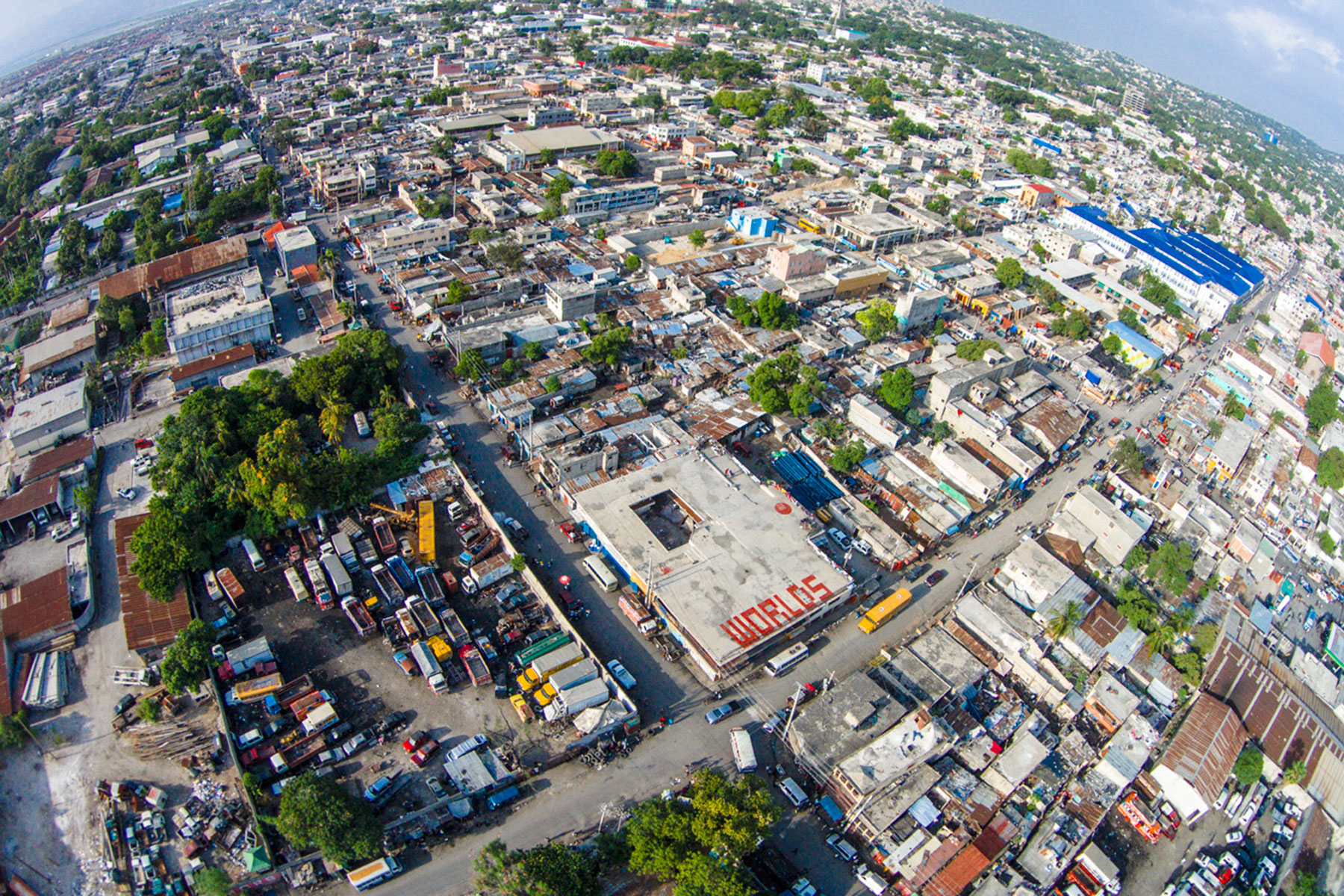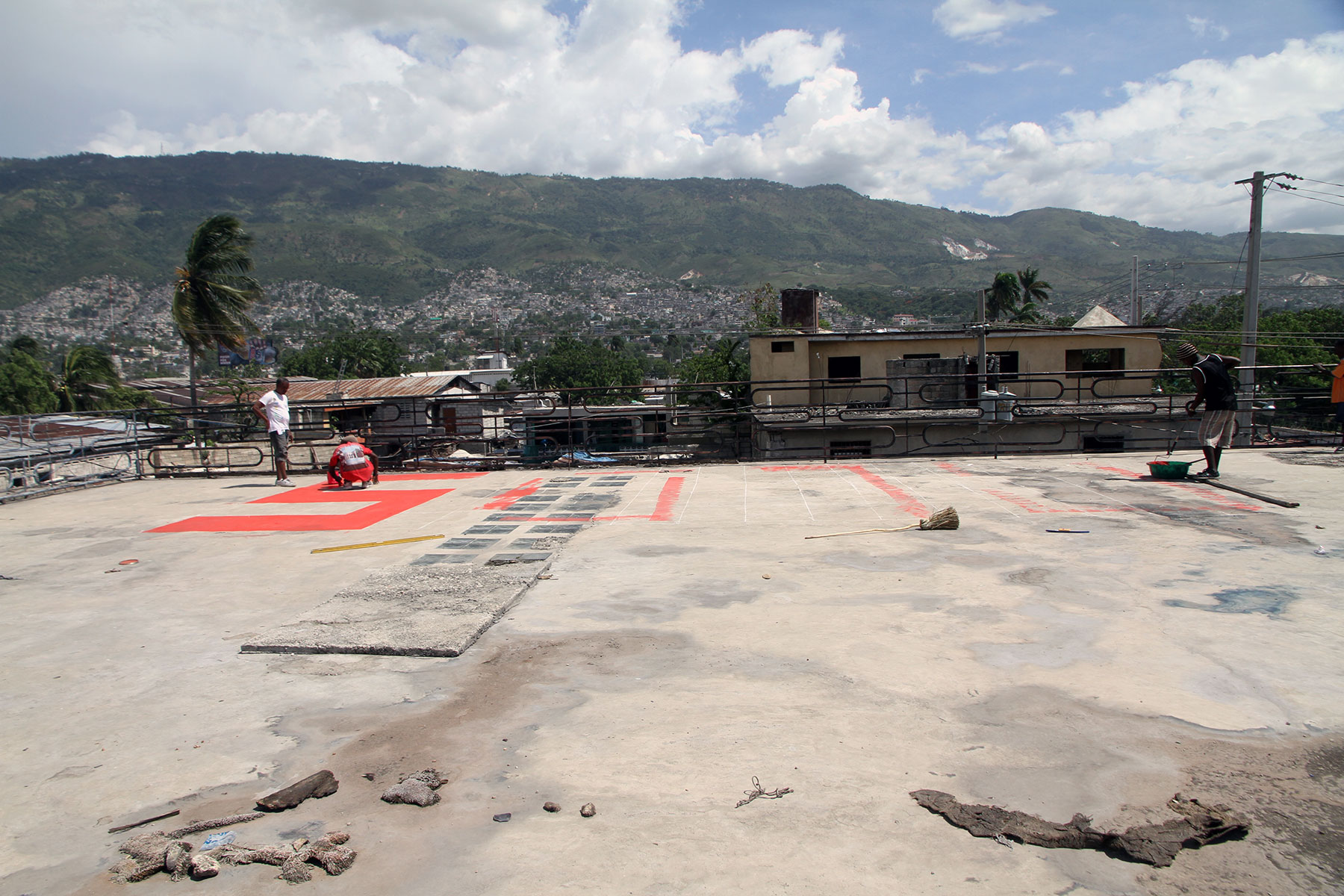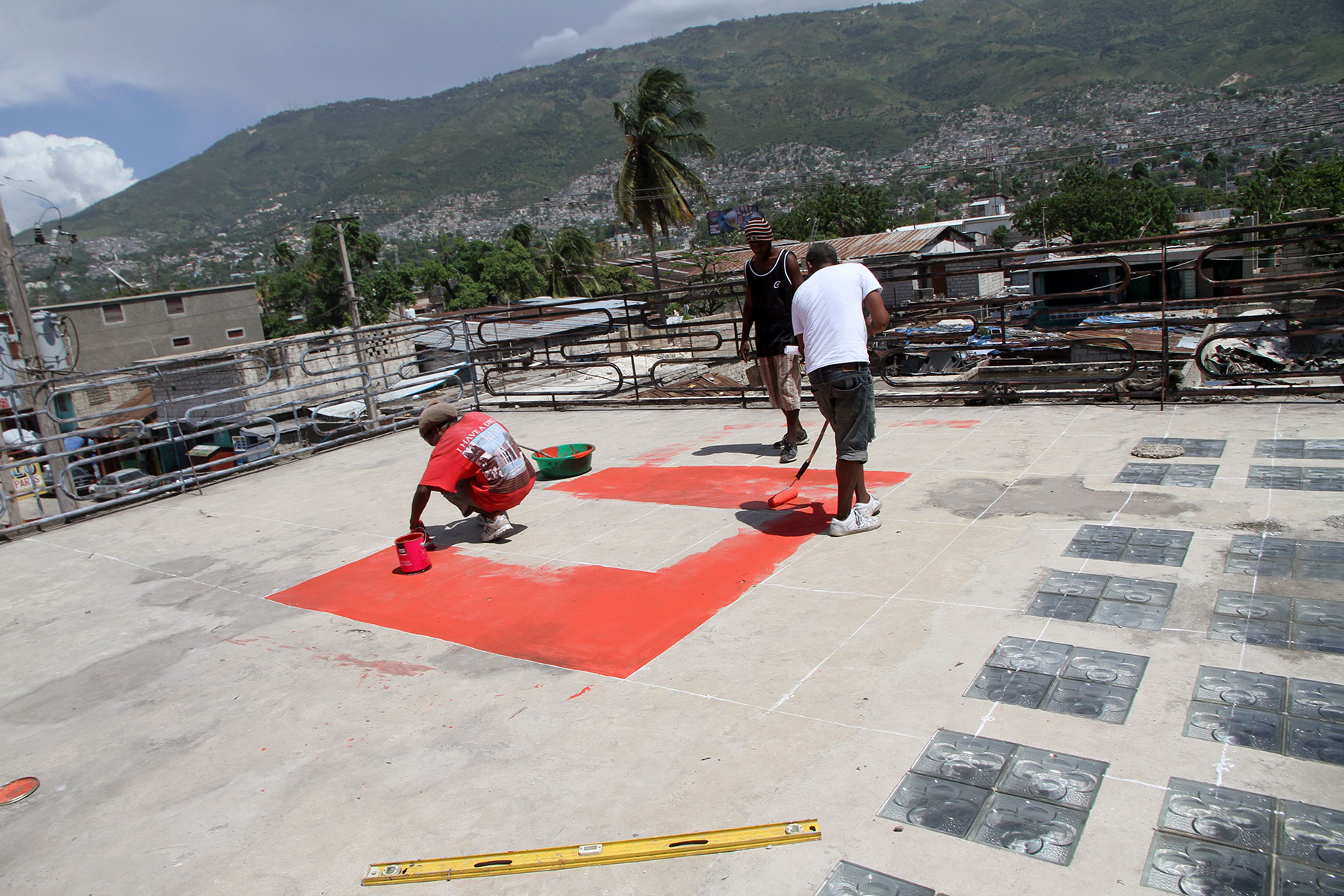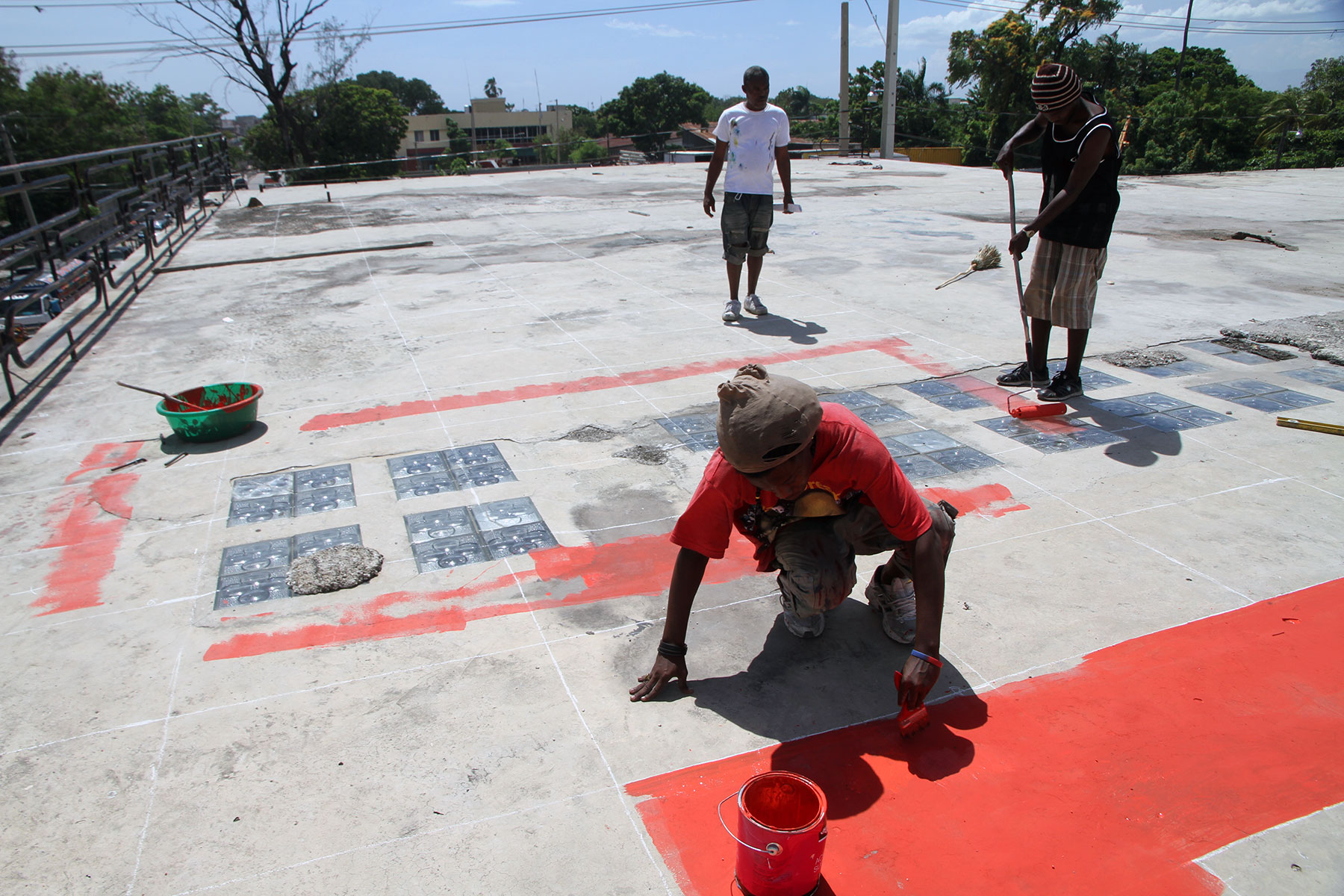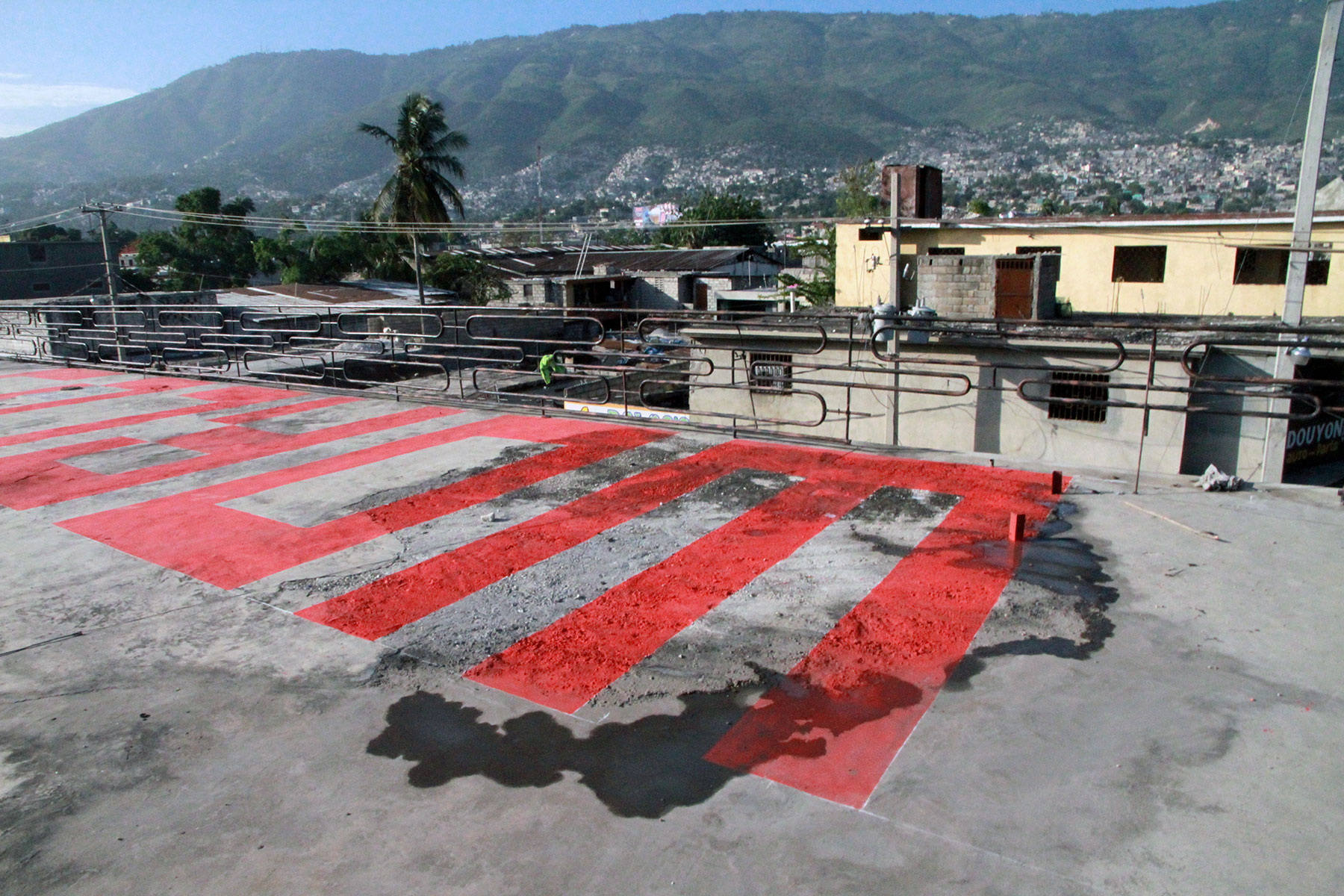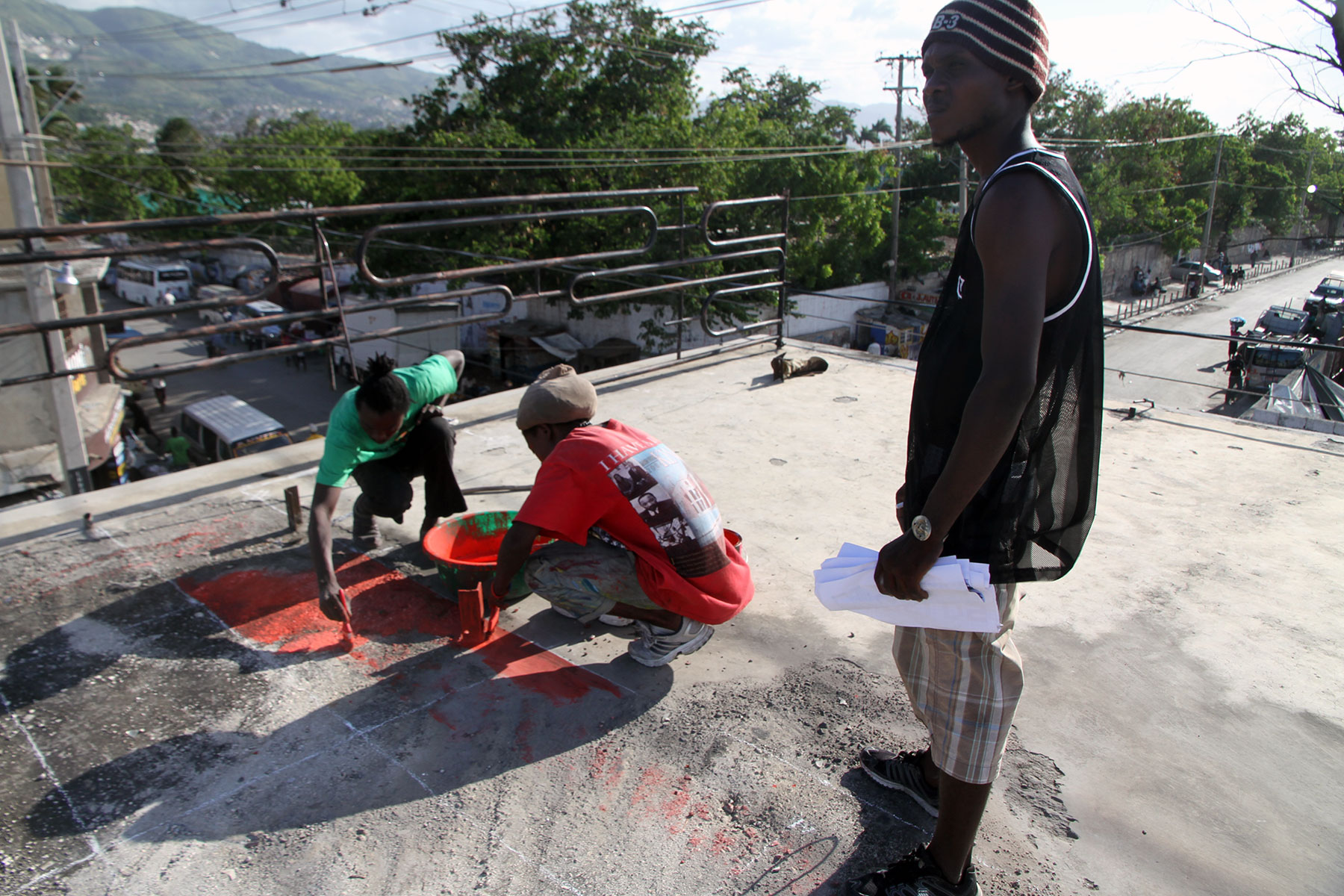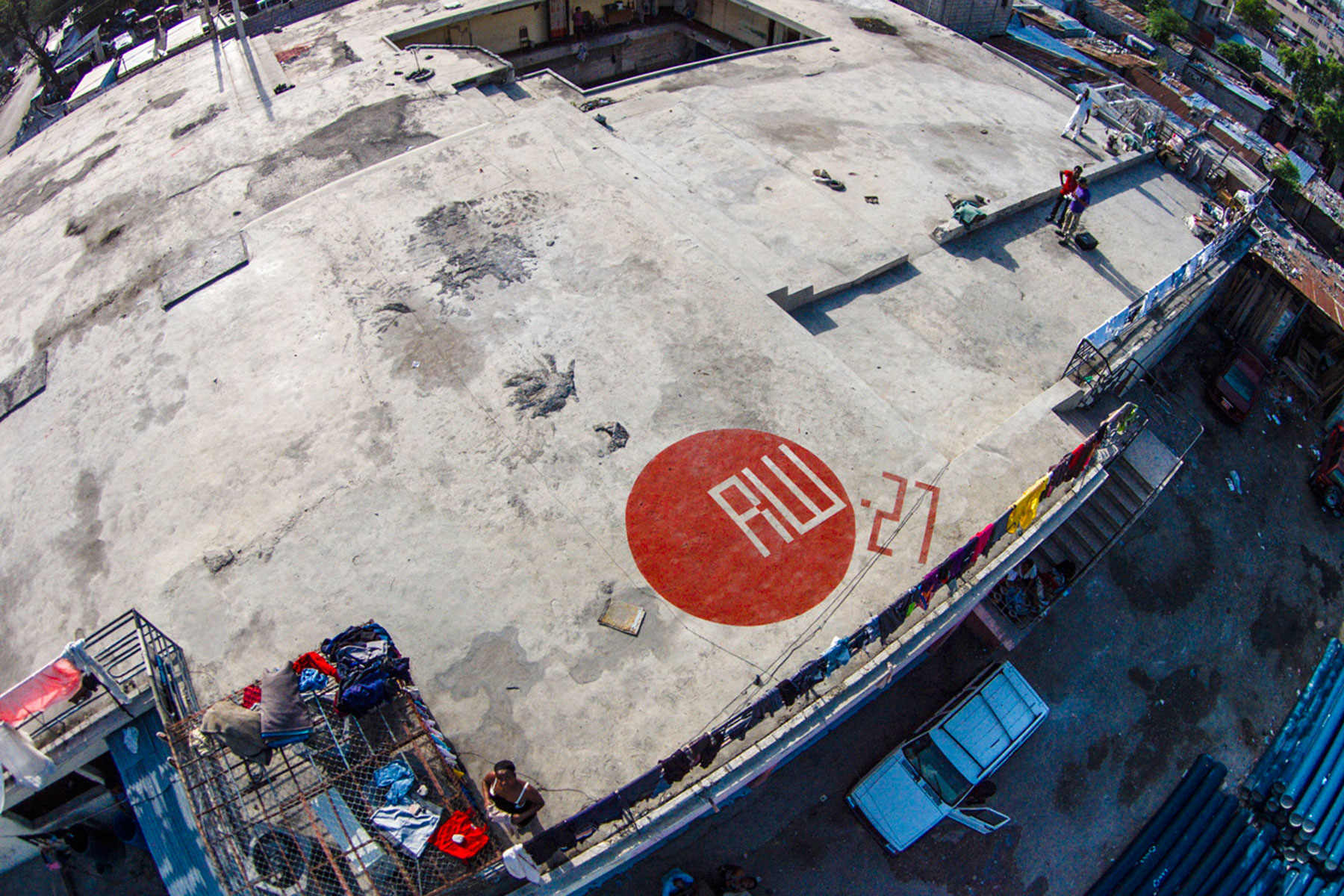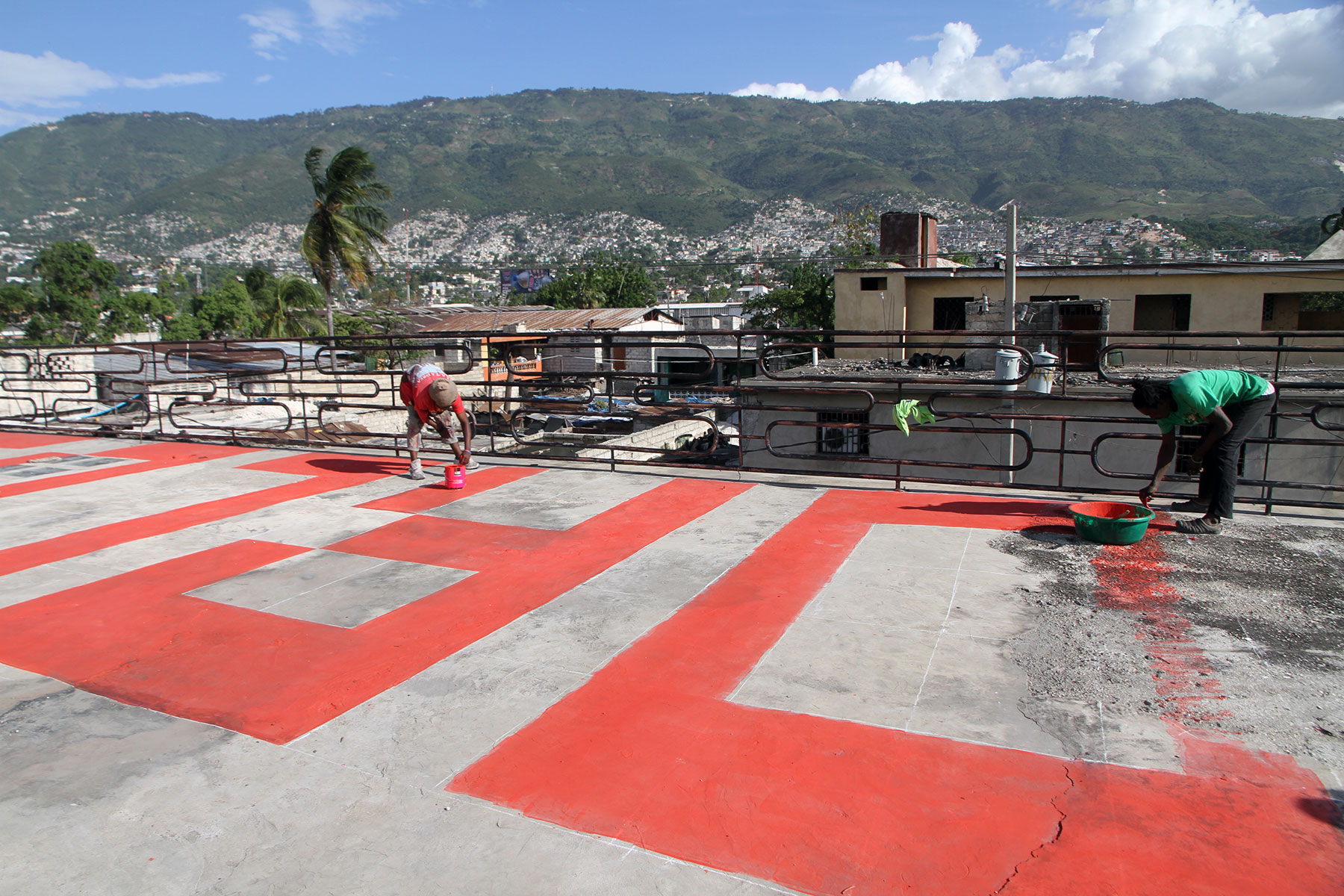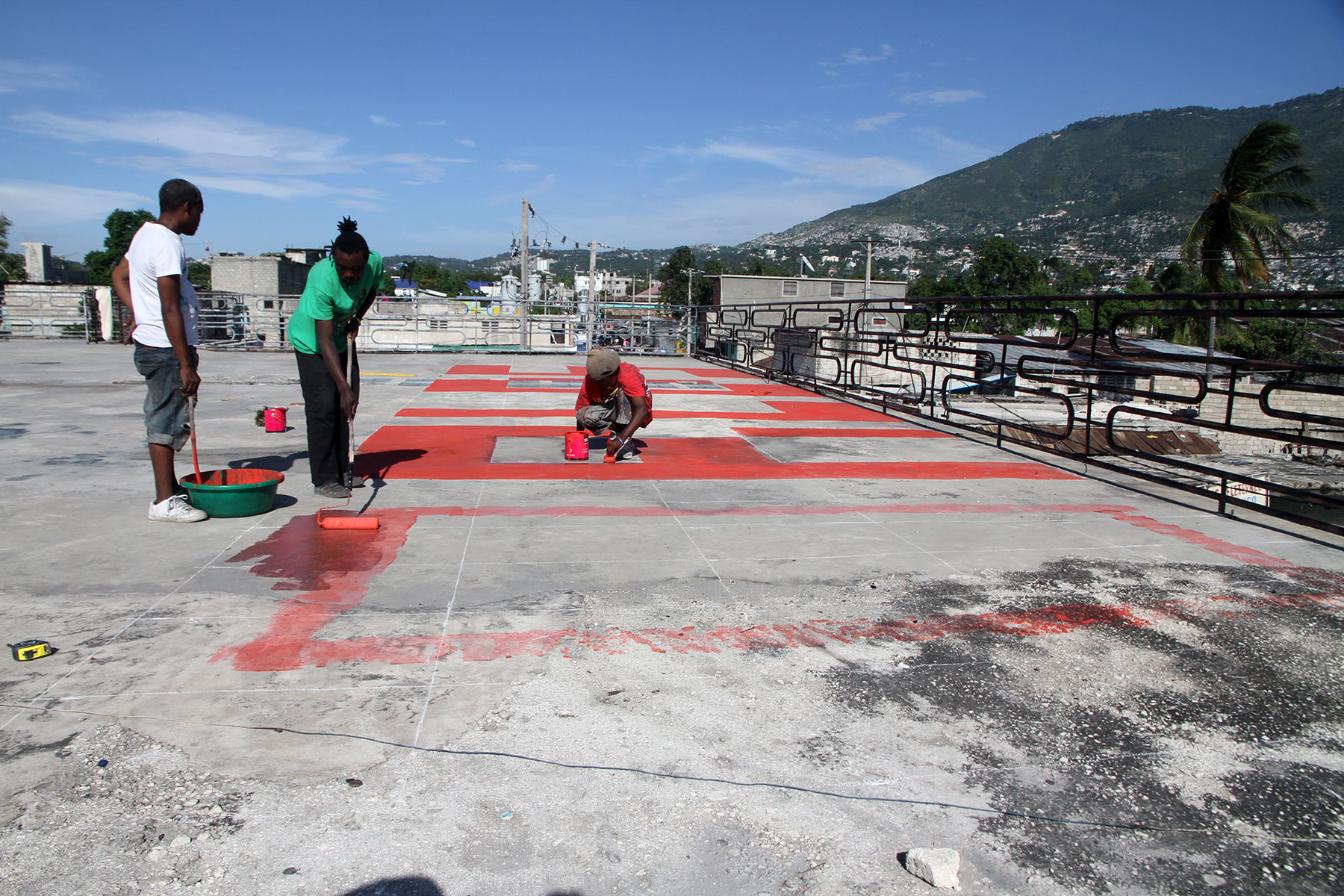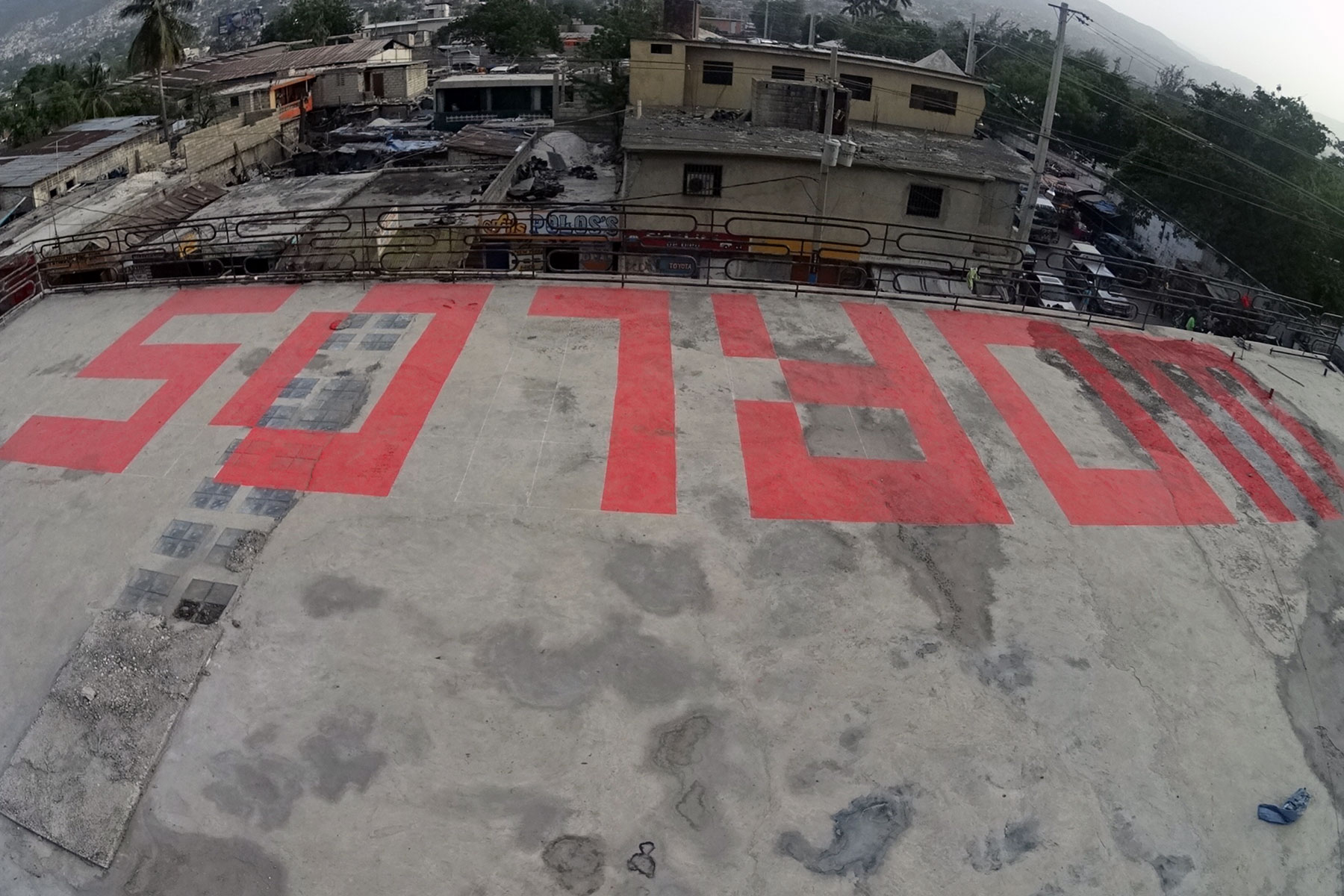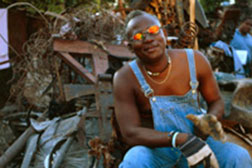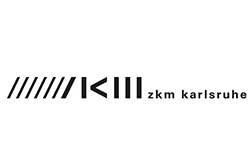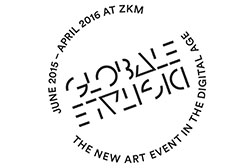FIVE ROOFS | FIVE CONTINENTS
ONE EARTH UNITES MANY WORLDS
In cooperation with ZKM | Center for Art and Media Karlsruhe, REMOTEWORDS installs a message with five words on five continents authored by Peter Weibel on the occasion of GLOBALE.
The second location to be realised is located in Port-au-Prince, Haiti, supported by on- site curators Leah Gordon and André Eugène. Gordon and Eugène are the co-directors of the Ghetto Biennale, which is hosted by the Haitian artist collective Atis Rezistans, that will open its 4th edition this year in November with the theme of KREYÒL, VODOU and the LAKOU: forms of resistance.
Installed | Location | GPS: 23-07-2015 | Port-au-Prince, Haiti, America | 18.5387861,-72.3482194
Author | Words | Curator on site: Peter Weibel | WORLDS | Leah Gordon and André Eugène, Ghetto Biennale Haiti
Exhibition: GLOBALE, ZKM | Center for Art and Media Karlsruhe, Germany
Roof Size | Font Size: 1300qm | 2,70m x 16,25m
On Air:
Read interview on the ZKM blog
INTERVIEW
“Die Welt ist im Augenblick so weit von Gerechtigkeit entfernt wie wohl noch nie”
Ein Gespräch zwischen Peter Weibel und REMOTEWORDS über Sprache & Digitalität, Globalisierung & Ungerechtigkeit, Expanded Art Territories & Globale Poems.
REMOTEWORDS: 1973 hast Du in einer spektakulären Aktion Deine Zunge einbetonieren lassen, eine Deiner diversen Arbeiten an der Schnittstelle von Sprache, Schrift, Bild und Medium. Was hat Dich gereizt, das Konzept von REMOTEWORDS, einem Ansatz der mit aktuellen Medien und virtuellen Globen funktioniert, im Zusammenhang Deines sprachbezogenen Ansatzes zu nutzen? Und worin liegt hierbei für Dich der Unterschied zu anderen Arbeiten, die Du bisher mit Sprache gemacht hast?
Peter Weibel: Die Aktion mit der Zunge heißt ja »Raum der Sprache«. Ich wollte – in einem extrem materialistischen Ansatz, extremer als der Physikalismus der Philosophie des Wiener Kreises – darauf hinweisen, dass Sprache primär ein Lautstrom ist, der als Schallwellen, in Schwingung versetzte Luft, gemessen werden kann. Schallwellen breiten sich im Raum aus. So ist also die Sprache ein Medium des Raumes. Sie definiert Raum, indem sie die Distanz bestimmt, innerhalb welcher ein Mensch gehört werden kann. Mit der Sprache werden also territoriale Grenzen festgesetzt. Wir haben Technologien wie etwa Mikrofon, Radio und Lautsprecher erfunden, um die natürlichen Grenzen des Sprachraums zu überwinden.
Ebenso hat mich interessiert, wieso der Mensch diesen bloßen Äußerungen eines Lautstroms so viel Bedeutung beimisst, gerade indem er dem Lautstrom, den Ketten von Vokalen, Konsonanten und Wörtern, Bedeutung verleiht.
Menschen sitzen in einem Saal, sei es im Parlament, sei es in einem Gerichtssaal, und erzeugen Schallwellen, Ketten von Lauten. Aber diese Schallwellen haben enorme ontologische Konsequenzen. Ein Mensch verlässt den Saal, den Raum der Sprache, als freier oder als gefangener Mensch. Das Parlament beschließt Gesetze, die eine Unzahl von Menschen in ihrer Existenz bedroht, wenn nicht zerstört. Die ontologischen Implikationen von Zeichenketten haben mich also interessiert. Ich war gewissermaßen ein früher Kritiker der Sprechakttheorie. Die Sprache wird als Gefängnis erkennbar, wie die drei Dimensionen des Raumes x,y,z ebenfalls die drei Gitterstäbe des Raumgefängnisses bilden. Ich wollte also zeigen: Die Zunge spricht nicht frei. Der Sprechende wird nicht frei durch das Sprechen. Die Zunge ist einbetoniert, gefangen in der Sprache und im Raum. Das Subjekt ist ein Gefangener der Sprache und muss daher Wege finden, um aus der Sprache auszusteigen. Die Technologie schien mir immer eine Möglichkeit, die Gitterstäbe von Raum und Zeit, das Gefängnis der Sprache, zumindest zeitweilig zu verlassen. Deswegen interessierte ich mich schon in meinen frühen Aktionen und Dichtungen für die technischen Medien und das Virtuelle als Gegensatz zum Wirklichen.
Wörter bestehen nicht nur aus Buchstaben, sondern bilden auch Zellen, Sinnzellen, Gefängniszellen, in die Bedeutung eingesperrt ist. Darum sprachen schon viele Dichter von den »Parole in Libertà« (Marinetti, 1912), von der Explosion der Buchstaben und Bedeutungen, vom Ausbruch aus der Sprache. Ende des 19. Jahrhunderts, beispielsweise Mallarmé und Apollinaire) begannen die Dichter damit, die Wörter auf der Fläche zu verteilen, erste Maßnahmen, die Wortketten zu entketten, der Beginn der konkreten und visuellen Poesie. Die Entfernungen zwischen den Buchstaben wurden größer und sinngestaltend.
Ihr habt nun die Wörter nicht nur über Buchseiten verteilt, sondern über den ganzen Erdball, also ein globales Poem geschrieben. Ihr habt also die Fläche bzw. Buchseite zur Erdoberfläche erweitert. Dadurch entsteht das Problem, dass die Seite zu groß ist, um von einem natürlichen Auge erfasst werden zu können. Dadurch brauchtet Ihr mehrere künstliche Augen – Drohnenaugen und Satellitenaugen. Erst deren Zusammenschau macht den Satz sichtbar und erkennbar.
RW: Unser Projekt REMOTEWORDS knüpft an die Tradition der Land Art an, denn wir nehmen lokale, analoge Einschreibungen auf der Erdoberfläche vor. Für die Globale haben wir Dir vorgeschlagen einen fortlaufenden Satz mit fünf Wörtern auf den fünf Kontinenten zu installieren. Wir beide gehen in unseren Projekten oft von einer Idee der Erweiterung aus. Du gehörst zu den Pionieren des „Expanded Cinema“, und vielleicht könnte man sagen, dass wir mit den 5 Dächern auf 5 Kontinenten den Globus selbst zu einem „Expanded Art Territory“ gemacht haben. Wie würdest Du den Zusammenhang von Sprache und Landschaft und deren relativ neue mediale Darstellungsform als virtuelle Globen im Falle unserer Kollaboration beschreiben?
PW: Sprache und Raum sind also immer medial vermittelt, sei es durch Schallwellen oder Lichtwellen. Indem Ihr die Wörter über den ganzen Globus verteilt habt, habt Ihr die Wörter soweit disloziert, soweit voneinander entfernt, dass sie nur durch mediale Vermittlung lesbar sind. Diese Wörter markieren keine Buchseiten, sondern Landschaften – aber keine natürlichen, sondern industrielle Landschaften, von Menschen gemachte Flächen. Da es fünf Kontinente gibt, fünf kontinentale Flächen, mit den Meeren als Leerstelle, lag die Idee nahe, fünf Wörter zu finden, welche die fünf Kontinente besetzen. Jedes einzelne Wort bietet für den einzelnen Betrachter vor Ort nur eine fragmentarische Bedeutung, der lokale Leser ist nicht im Stande, mehr als den Sinn eines Wortes zu erfassen. Sein Kenntnisstand bleibt so vereinzelt wie das Wort selbst. Erst die Leser, die mithilfe von Technologie alle Standorte einnehmen können, und seien sie auch nur virtuell, können die Bedeutung aller einzelnen Wörter zu einem ganzen Satz vereinen, d.h. eine Aussage. Die Erfassung einer Aussage bedarf also mehrerer Standpunkte. Der lokale Bewohner einer Nation sieht nur aus der Perspektive seiner Nation und blendet die Sichtweisen anderer Nationen aus. Angesichts des Schicksals der Erde, »Facing Gaia« (Bruno Latour) müssen wir von einer lokalen zu einer globalen Perspektive übergehen, um diesen Erdball vor seiner Zerstörung durch den Menschen selbst zu retten. Wir haben nämlich nur eine Erde, aber viele Sprachen, viele Kulturen, viele Religionen, viele Ethnien, die sie bewohnen möchten. Daher habe ich euch als Satz mit fünf Worten für die fünf Kontinente »ONE EARTH UNITES MANY WORLDS« vorgeschlagen. Wir erleben heute wieder, dass gerade Politik und Religion die Menschen auf grausamste Weise trennen, aber die Kunst die Möglichkeit hat, die Menschen zu vereinen – zumindest zu zeigen, mit welchen Methoden, z.B. multiplen Perspektiven, die Menschen vereint werden könnten.
RW: Stellt die indirekte Rezeption von Sprache über die mediale Apparatur (Satellit, Computer) aus Deiner Sicht eine Absurdität oder eine Vertiefung dar?
PW: Aufgrund der vorigen Aussagen, bedeutet der Einsatz medialer Apparatur eine Expansion und somit Vertiefung der sprachlichen Werkzeuge und der Mächtigkeit der Sprache.
RW: Wir finden, Dein Text ONE EARTH UNITES MANY WORLDS hat sehr viele Aspekte zu bieten, die für heutige, auch uns beschäftigende Diskussionen von Belang sind. Das semantische Spiel mit den Worten EARTH und WORLDS kann, wie wir meinen, doppelt gelesen werden – einerseits wird „earth“ als geografischer Ort aufgerufen, andererseits die „worlds“ als Raum geistiger und virtueller Imaginationen. Dadurch stellt der Satz für mich ein fast greifbares Bild von Globalität in ihren Möglichkeiten, aber auch ihren Problemen dar. Du hast den Satz ja innerhalb Deiner Überlegungen zur von Dir so genannten „Infosphere“ entwickelt. Kannst Du die Bezüge von Digitalität, Globalisierung und Informationssphäre genauer darlegen?
PW: Bei Eurer Arbeit handelt es sich tatsächlich um eine neue Gleichung von Sprache und Raum, die sowohl auf die visuelle Poesie als auch die Land Art zurückgreift. Im globalen Zeitalter, d.h. im Zeitalter, in dem eine Hülle von elektromagnetischen Wellen den Globus umgibt, durch die Milliarden von Informationen im Sekundentakt verteilt werden, wird der Globus selbst zu einer Seite. Der Leser sitzt vor mehreren Buch- bzw. Bildseiten gleichzeitig. Schon die parallelen Fernsehprogramme haben den Betrachter gelehrt, gleichzeitige Optionen gegeneinander abzuwägen. Durch 50 Kanäle hat er 50 Blickwinkel auf die Welt, von Nachrichten bis Soap Operas. Die Infosphäre hat die Wahlmöglichkeiten um ein Vielfaches erhöht. Je umfassender die Infosphäre, um so mehr kann der Benutzer zwischen Informationen wählen. Natürlich gibt es bei der Auswahl der Informationen natürliche Schranken wie die » kognitive Dissonanz« (Leo Festinger, 1957), dass also Menschen dazu neigen, nur die Information zu rezipieren, die ihre vorgefassten Vorurteile bestätigt anstatt korrigiert. Dennoch bedeutet die Infosphäre die Expansion des Informationsraumes von lokaler zu globaler Größe. Dies ist nur durch eine fortschreitende Mathematisierung der Welt seit 1800 möglich geworden und durch den Aufstieg der drahtlosen Funktechnologie (1886–1888). Das Ergebnis dieser beiden Tendenzen heißt Digitalisierung. Haben wir bisher den Dingen und Menschen nur Namen, Bilder und Töne gegeben, sind wir nun in der Lage, die Dinge, Wörter, Bilder und Töne in Daten zu verwandeln. Die Daten wiederum können wir in Dinge, Wörter, Töne und Bilder rückverwandeln. Dieser Zusammenhang von Infosphäre, Globalisierung und digitale Welt bedeutet eine radikale Transformation des Verhältnisses von Mensch und Natur. Der Mensch wird nun selbst verantwortlich für seine Umwelt – das ist die Idee des Anthropozän. Ein Grundgesetz des Anthropozän könnte lauten: ONE EARTH UNITES MANY WORLDS.
RW: In einer Zeit, die von weltweiter Agitation, politischer und religiöser Radikalisierung, kulturhistorischem Vandalismus, „neuer Barbarei“, Separatismus und Krieg gekennzeichnet ist, hat sich Deine Nachricht für mich schon vor einem Jahr, als wir sie entwickelt haben, „antizyklisch“ ausgenommen. Und heute erscheint mir diese Formulierung wie eine überraschend präzise Prognose der momentanen Ereignisse – die verschärfte Flüchtlingsproblematik in Europa, die drohende Splittung von Syrien, das Treiben des IS. Wie ein politischer Appell zur Besonnenheit, eine Erinnerung daran, dass Pluralismus und Diversität die Grundlagen sozialen Zusammenlebens sind. Im Interview zu „300 Tage / 300 Köpfe“ sprichst Du nun davon, dass „Ungerechtigkeit“ Dich seit jeher und immer noch beschäftigt – und dass Du ihre Abschaffung als hoch gestecktes Ziel siehst…
PW: Eure Botschaft ist in der Tat eine globale Botschaft, um nicht zu sagen, eine planetarische. Ihr setzt die Arbeit von Buckminster Fuller fort, der in seinem Buch Spaceship Earth (1968) auf das Fehlen einer Betriebsanleitung für das Raumschiff Erde hingewiesen hat und die Architekten, Designer, Ingenieure und Handwerker aufforderte, sich endlich an die Arbeit zu machen, so ein Manual herzustellen. Was Ihr antizyklisch nennt, nenne ich prophetisch. Ein Großteil meiner Arbeiten hat prophetische Züge, d.h. sie sind quer zur Gegenwart, werden aber von der Zukunft bestätigt. Es freut mich, dass dies auch Euch aufgefallen ist. Die Welt ist im Augenblick so weit von Gerechtigkeit entfernt wie wohl noch nie. Der monetäre Reichtum der Welt ist nicht mehr in den Händen von einigen Nationen versammelt, wie Adam Smith noch glaubte (The Wealth of Nations, ca. 1776), sondern in den Händen weniger. Das Hauptwerk des gegenwärtigen Kapitalismus müsste lauten The Wealth of the Few. Die Kluft zwischen Nord und Süd wird durch die Klimakrise, genauer gesagt die Erderwärmung, immer größer. Das Projekt »globale Gerechtigkeit« wird also immer schwieriger.
INTERVIEW
„The world is at the moment as far removed from justice as never before“
A conversation between Peter Weibel and REMOREWORDS about language & digitalism, globalisation & injustice, expanded art territories & global poems.
REMOTEWORDS: In a spectacular performance in 1973 you encased your tongue in concrete, one of your multiple works at the interface of language, writing, image, and medium. What did attract you to use the concept of REMOTEWORDS, an approach that works with contemporary media and virtual globes, in connection with your linguistic approach? And what is the difference to other linguistic works you have done before?
Peter Weibel: The performance with the tongue is entitled »Raum der Sprache« (The Space of Language). My aim was – with an extremely materialistic approach, more extreme than the physicalism of the philosophy of the Vienna circle – to point out that language is primarily a flow of sound, which can be measured as soundwaves, as vibrating air. Soundwaves expand in space. So language is a medium of space. It defines space by determining the distance in which a person can be heard. So language defines territorial borders. We have invented technologies like microphones, radio, and loudspeakers to overcome the natural borders of language space. At the same time it interested me why humans add so much meaning to the pure expression of a flow of sound, especially by adding meaning to the flow of sound itself, the vowels, consonants, and words.
Humans sit in a hall, be it in parliament, be it at court, and create soundwaves, chains of sounds. But these soundwaves have enormous ontological consequences. A human leaves the hall, the space of language, either free or imprisoned. The parliament decides on laws which threaten the existence of an immense number of people, or even destroy it. The ontological implications of strings of characters are what interested me. In a way I was an early critic of the speech act theory. Language is identifiable as prison, just like the three dimensions of space x,y,z form the bars of the space prison. I wanted to show: the tongue does not speak freely. The speaker does not become free by speaking. The tongue is encapsulated in concrete, captured in language and space. The subject is a prisoner of language and has to find ways to exit language. To me technology always presented a means of leaving the prison bars of time and space, the prison of language, at least for a while. This is why I was interested in the technical medium and the virtual as a contrast to reality, already in my early works and poems.
Words do not only consist of letters, but also form cells, cells of meaning, prison cells, which encapture meaning. This is why many poets spoke of the »Parole in Libertà« (Marinetti, 1912), of the explosion of letters and meanings, of the outbreak from language. At the end of the 19th century (for example Mallarmé and Apollinaire), poets began to spread out words over space, first measures, the beginning of concrete and virtual poetry. The distance between letters began to grow and meaningful.
You have now spread words not on book pages, but across the globe, therefore written a global poem. You have expanded the surface or rather the book page to the surface of the earth. This creates the problem that the page is too large to be register by the human eye. Therefore you need multiple artificial eyes – drone eyes and satellite eyes. It is only their integrated view that makes the sentence visible and recognisable.
RW: Our project REMOTEWORDS is tied to the tradition of land art, as we carry out local, analogue inscriptions on the earth’s surface. For the Globale we suggested you to install a continuous sentence with five words on the five continents. Us both often originate in an idea of expansion in our projects. You are one of the pioneers of ‘expanded cinema’, and maybe one could say that with the five roofs on five continents we have made the globe itself into an ‘expanded art territory’. How would you describe the context between language and landscape and their relatively new medial form of presentation as virtual globes in the case of our collaboration?
PW: Language and space are therefore always conveyed medially, be it through soundwaves or lightwaves. By spreading the words all over the globe you have displaced the words, removed them from each other insofar that they are only readable through medial procurement. These words do not mark book pages but landscapes – but not natural ones but industrial landscapes, surfaces created by humans. As there are five continents, five continental surfaces, with the oceans as empty space, it seemed reasonable to find five words to occupy the five continents with. Each single word offers the local observer only a fragmented meaning, the local reader is not able to understand more than the meaning of the word. His level of knowledge remains as isolated as the word itself. Only the readers who are able to occupy all locations with the help of technology, and be that only virtual, are able to combine the meaning of all single words to a full sentence, i.e. a statement. The registration of a statement requires multiple positions. The local inhabitant of a nation sees everything from the perspective of his nation and blanks out the viewpoints of other nations. When faced with the fate of earth, »Facing Gaia« (Bruno Latour), we have to move from a local to a global perspective, to save this globe from destruction by humankind itself. We only have one earth, but many languages, many cultures, many religions, many ethnicities, which would like to inhabit it. Therefore I suggested »ONE EARTH UNITES MANY WORLDS« as sentence with five words for five continents. »ONE EARTH UNITES MANY WORLDS.« Today we again experience how politics and religion cruelly divide people, but that art has the possibility to unite the people – or at least to show with what methods, for example multiple perspectives, humans can be united.
RW: In our opinion, does the indirect reception of language via the medial apparatus (satellite, computer) mean an absurdity or deepening?
PW: As stated previously, the use of the medial apparatus means an expansion and therefore deepening of the linguistic tools and the force of language.
RW: We think that your text ONE EARTH UNITES MANY WORLDS offers many aspects that are important for the contemporary discussions which also affect us. The semantic play with the words EARTH and WORLDS can, in our opinion, be read in a dual sense – on the one hand „earth“ is invoked as geographical location, on the other „worlds“ as a place of spiritual and virtual imagination. Therefore the sentence for me means an almost haptic image of globalism in its possibilities but also its issues. You have developed that sentence within your considerations towards the „Infosphere“ as you called it. Can you outline the references between digitalism, globalism and information sphere in more detail?
PW: Your work actually is a new equation of language and space, which falls back on both visual poetry and land art. In the global age, i.e. in an era when a hull of electromagnetic waves surrounds the globe through which billions of informations are spread every second, the globe itself becomes a page. The reader sits in front of multiple book- or image pages at the same time. Even the parallel TV channels have taught the observer to balance between simultaneous options. Through 50 channels he has 50 perspectives of the world, from the news to soap opera. The infosphere has increased the options many times over. The more extensive the infosphere, the more the user can choose between information. Of course there are natural barriers to the ingestion of information, like the »cognitive dissonance« (Leo Festinger, 1957), where humans tend towards only to receive information that confirms their preconceived prejudices instead of correcting them. Nevertheless, the infosphere means the expansion of the informational space from local to global size. This has only been made possible by the progressing mathematisation of the world since 1800 and the rise of wireless radio technology (1886-1888). The result of these two tendencies is called digitalisation. So far we have only given names, images and sounds to things and humans, but now we are capable of transforming things, words, images, and sounds into data. We can then re-transform data into things, words, sounds, and images. This connection between infosphere, globalisation and the digital world means a radical transformation of the relationship between man and nature. Mankind is now responsible for its environment – this is the idea of the Antropocene. A basic law of the Antropocene could be: ONE EARTH UNITES MANY WORLDS.
RW: In a time marked by worldwide agitation, political and religious radicalisation, historico-cultural vandalism, „new barbarism“, separatism, and war, I perceived your message a year ago, when we developed it, as „anticyclical“. And now it seems to me that the phrasing was a surprisingly accurate forecast of contemporary events – the refugee crisis in Europe, the threatening split of Syria, the action of IS. Like a political appeal for more prudence, a reminder that pluralism and diversity are the foundations of social cohabitation. In the „300 Tage / 300 Köpfe“ interview you state that „injustice“ has always preoccupied you – and that you view its elimination as a highly ambitious goal…
PW: Your message is indeed a global message, not to say a planetary one. You continue the work of Buckminster Fuller, who points out in his book Spaceship Earth (1968) that the spaceship earth is lacking a manual and asked the architects, designer, engineers, and craftsmen to finally get to work. What you call anticyclical I call prophetic. A large portion of my work has prophetic straits, i.e. they are diagonally to the present, but will be confirmed by the future. I’m delighted that you have realised this. The world is at the moment as far removed from justice as never before. The financial wealth of the world is no longer gathered in the hands of some nations, as Adam Smith believed (The Wealth of Nations, ca. 1776), but in the hands of a few. The main work of contemporary capitalism should be called The Wealth of the Few. The gap between north and south is constantly widening through the climate catastrophe, or to be more precise through global warming. The project »global justice« is becoming increasingly difficult.


